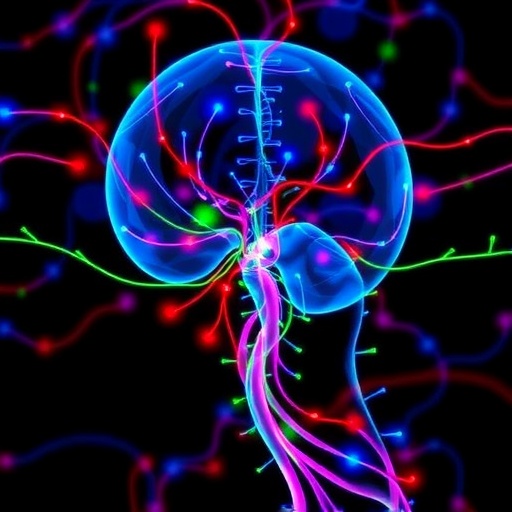In a groundbreaking advancement at the forefront of neuromodulation research, scientists have unveiled a pivotal discovery linking two seemingly distinct nerve stimulation techniques through a common biophysical mechanism. This revelation not only deepens our fundamental understanding of peripheral nerve activation but also promises to revolutionize therapeutic strategies that harness electrical stimulation for clinical purposes. At the core of this discovery lies the intricate interplay of electrical currents applied via high-frequency signals to stimulate nerves in a controlled and targeted manner, a method that holds immense potential for non-invasive treatment modalities.
Peripheral nerve stimulation has long been a subject of fascination for both neuroscientists and clinicians, particularly due to its vast therapeutic implications ranging from pain management to motor function restoration. Traditional stimulation methods, however, often grapple with challenges such as non-specific activation and limited penetration depth. This new study meticulously dissects two prominent stimulation paradigms—temporal interference (TI) and direct kilohertz (kHz) frequency stimulation—focusing on their underlying neurophysiological effects on nerve fibers.
Temporal interference stimulation, a relatively novel approach, utilizes the superposition of multiple high-frequency electrical signals that differ slightly in frequency. When these signals intersect within biological tissues, they generate a low-frequency envelope capable of selectively stimulating deep neural targets while sparing surrounding structures. This property makes TI stimulation highly appealing for achieving focused neuromodulation without the need for invasive electrode placement. Until now, the exact mechanism by which TI affects peripheral nerves remained somewhat elusive.
On the other hand, direct kHz stimulation—a method involving continuous application of high-frequency electrical waves—has demonstrated efficacy in modulating nerve activity, often utilized in clinical pain interventions and neuroprosthetics. Despite its therapeutic success, the biophysical underpinnings explaining how such high-frequency currents translate into effective neural excitation were not fully elucidated, raising questions about the fundamental nature of nerve fiber responsiveness to such stimuli.
The research team approached these knowledge gaps by designing a comprehensive set of experiments that combined computational modeling with in vivo electrophysiological recordings. Their goal was to pinpoint the precise biophysical interactions that dictate nerve excitation in response to both TI and direct kHz stimulations, fostering a coherent explanatory framework that could unify these neuromodulation techniques at a mechanistic level. Their findings indicate that, contrary to prevailing assumptions, both methods leverage the same foundational principle—low-pass filtering properties of the nerve membrane that modulate ion channel dynamics and subsequently influence action potential generation.
In their computational models, the authors simulated the interaction of high-frequency currents with nerve fiber membranes exhibiting non-linear electrical characteristics. The results underscored the nerve membrane’s capacity to transform high-frequency electrical inputs into effective low-frequency depolarizations due to its intrinsic filtering properties. This low-frequency component ultimately triggers the opening of voltage-gated ion channels, orchestrating the neural firing patterns observed experimentally. Hence, despite the apparent differences in stimulation paradigms, the underlying electrophysiological response converges on a shared biophysical pathway.
Empirical validation came from rigorous electrophysiological measurements recorded from peripheral nerve fibers subjected to both TI and direct kHz stimulation protocols. The neural response patterns were strikingly similar, revealing consistent firing thresholds, frequency dependence, and activation profiles. This congruence strongly supports the notion that both stimulation strategies engage the nerve tissue through the same fundamental biophysical mechanisms, which was a major revelation given their previous conceptual separation in the neuromodulation field.
The implications of this discovery extend beyond academic curiosity and into practical applications in medical technology. By understanding that TI and direct kHz stimulation share the same excitation pathway, researchers and clinicians can better optimize stimulation parameters to enhance efficacy, minimize side effects, and tailor interventions to individual patient needs. This can lead to the development of more precise, energy-efficient neuromodulation devices that maximize therapeutic outcomes while reducing invasiveness and discomfort.
Moreover, this integrated perspective enables the refinement of computational tools that predict nerve activation under various stimulation conditions, ultimately enhancing the design process of next-generation stimulators. It also provides a conceptual framework that can be applied to other neuromodulation domains, such as transcranial stimulation or deep brain stimulation, where similar principles may govern nerve and neural tissue responsiveness to electrical currents.
The study also emphasizes the importance of considering the biophysical constraints of the nervous system when interpreting neuromodulation results. It advocates for a paradigm shift away from viewing different high-frequency stimulation techniques as fundamentally distinct modalities, instead proposing a unified theory grounded in membrane biophysics. This perspective fosters interdisciplinary collaboration between electrophysiologists, biomedical engineers, and clinicians, seeking to translate these insights into tangible health benefits.
Additionally, the researchers highlight how temporal interference stimulation can harness spatial selectivity through interference patterns, while direct kHz stimulation relies on intensity and frequency modulation to achieve target activation. Yet, both ultimately converge on manipulating membrane ion channel gating via the nerve’s inherent low-pass filtering properties. Such nuanced understanding bridges the gap between device engineering and neurobiology, guiding future innovations in non-invasive therapies.
Another fascinating aspect revealed by the work is the potential to modulate stimulation waveforms to fine-tune neural recruitment selectively, potentially minimizing activation of off-target pathways that contribute to unwanted side effects. This could enhance patient comfort and safety in treatments for chronic pain, neuromuscular rehabilitation, and even neurodegenerative conditions by allowing precise spatial and temporal control over nerve excitation.
In light of these findings, the authors call for further exploration into how differential nerve fiber types respond to these stimulation modalities. Understanding variations in excitability among motor, sensory, and autonomic fibers could unlock bespoke neuromodulation regimens tailored for complex clinical presentations. This approach might extend therapeutic efficacy while curbing adverse effects, particularly pertinent to conditions requiring selective fiber targeting.
The research also opens intriguing possibilities for integrating these stimulation methods with emerging technologies such as closed-loop feedback systems that monitor neural responses in real time. By leveraging the common biophysical principles elucidated, adaptive stimulation devices could dynamically adjust parameters to maintain optimal nerve activation, fostering personalized and responsive neurotherapeutic interventions.
As the field rapidly evolves, this study stands as a seminal contribution that harmonizes disparate neuromodulation techniques under a unified mechanistic umbrella. By demystifying the fundamental nerve membrane dynamics triggered by high-frequency stimulation, it sets the stage for expansive innovation in neurotechnology, with profound implications for enhancing human health and quality of life.
Looking ahead, the confluence of computational models, biophysical insights, and experimental validation offers a powerful template for future research initiatives aimed at unraveling deeper complexities of nerve stimulation. The continued refinement and application of this foundational knowledge promise to accelerate the advent of sophisticated, minimally invasive solutions for a myriad of neurological disorders, shaping the future landscape of medicine.
In conclusion, this insightful research not only bridges an important conceptual divide in peripheral nerve stimulation methodologies but also exemplifies the power of integrative science in driving transformative advances. By elucidating the shared biophysical mechanism underlying temporal interference and direct kHz nerve stimulation, the study propels the neuromodulation field toward a more unified, mechanistically informed paradigm that stands to redefine therapeutic possibilities.
Subject of Research: Peripheral nerve stimulation; temporal interference; kilohertz electrical stimulation; biophysical mechanisms of nerve activation.
Article Title: The same biophysical mechanism is involved in both temporal interference and direct kHz stimulation of peripheral nerves.
Article References:
Opančar, A., Ondráčková, P., Rose, D.S., et al. The same biophysical mechanism is involved in both temporal interference and direct kHz stimulation of peripheral nerves. Nat Commun 16, 9006 (2025). https://doi.org/10.1038/s41467-025-64059-w
Image Credits: AI Generated
Tags: advancements in neuromodulation researchbiophysical mechanisms in neuromodulationchallenges in traditional nerve stimulation methodskilohertz frequency stimulationmotor function restoration techniquesnerve stimulation techniquesneurophysiological effects of nerve stimulationnon-invasive electrical stimulation treatmentspain management through nerve stimulationperipheral nerve activationtemporal interference stimulationtherapeutic strategies for nerve stimulation





